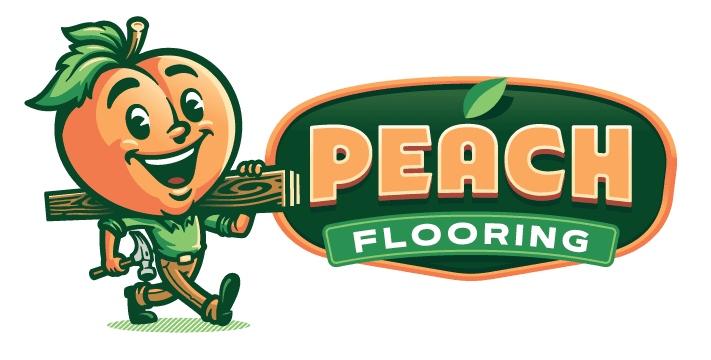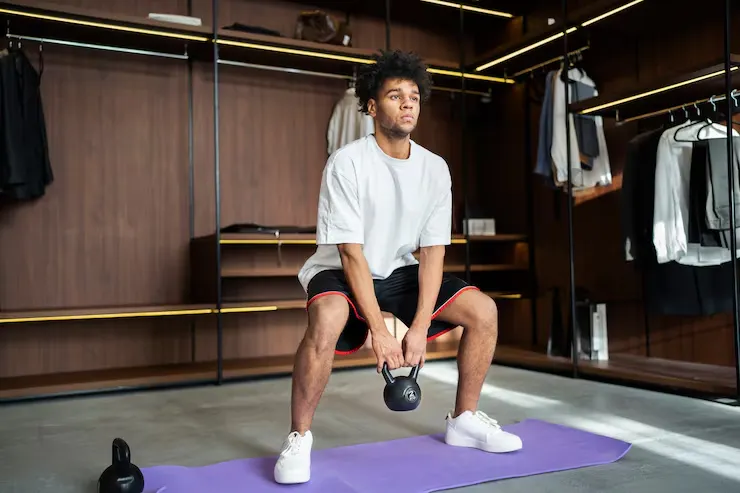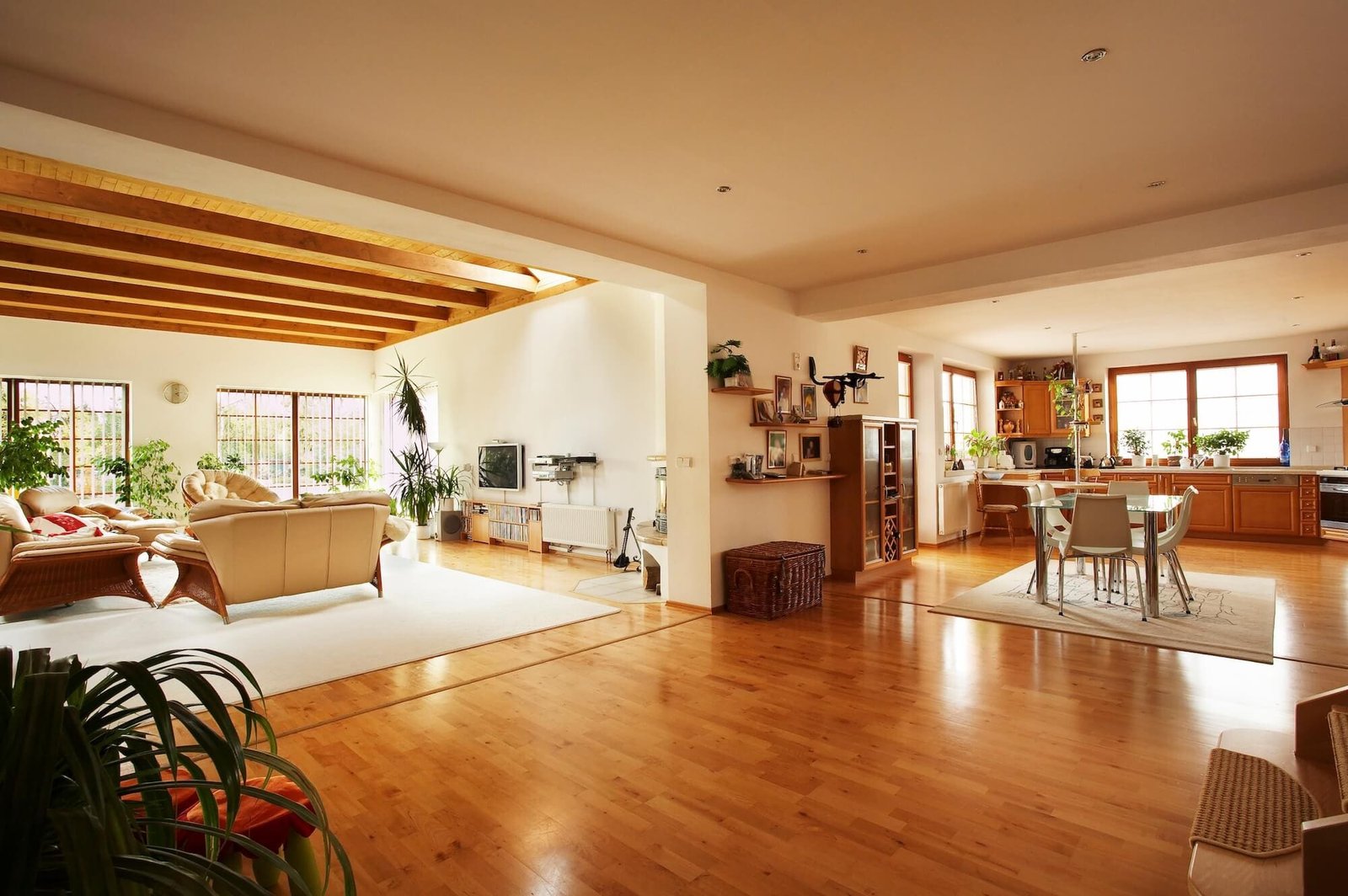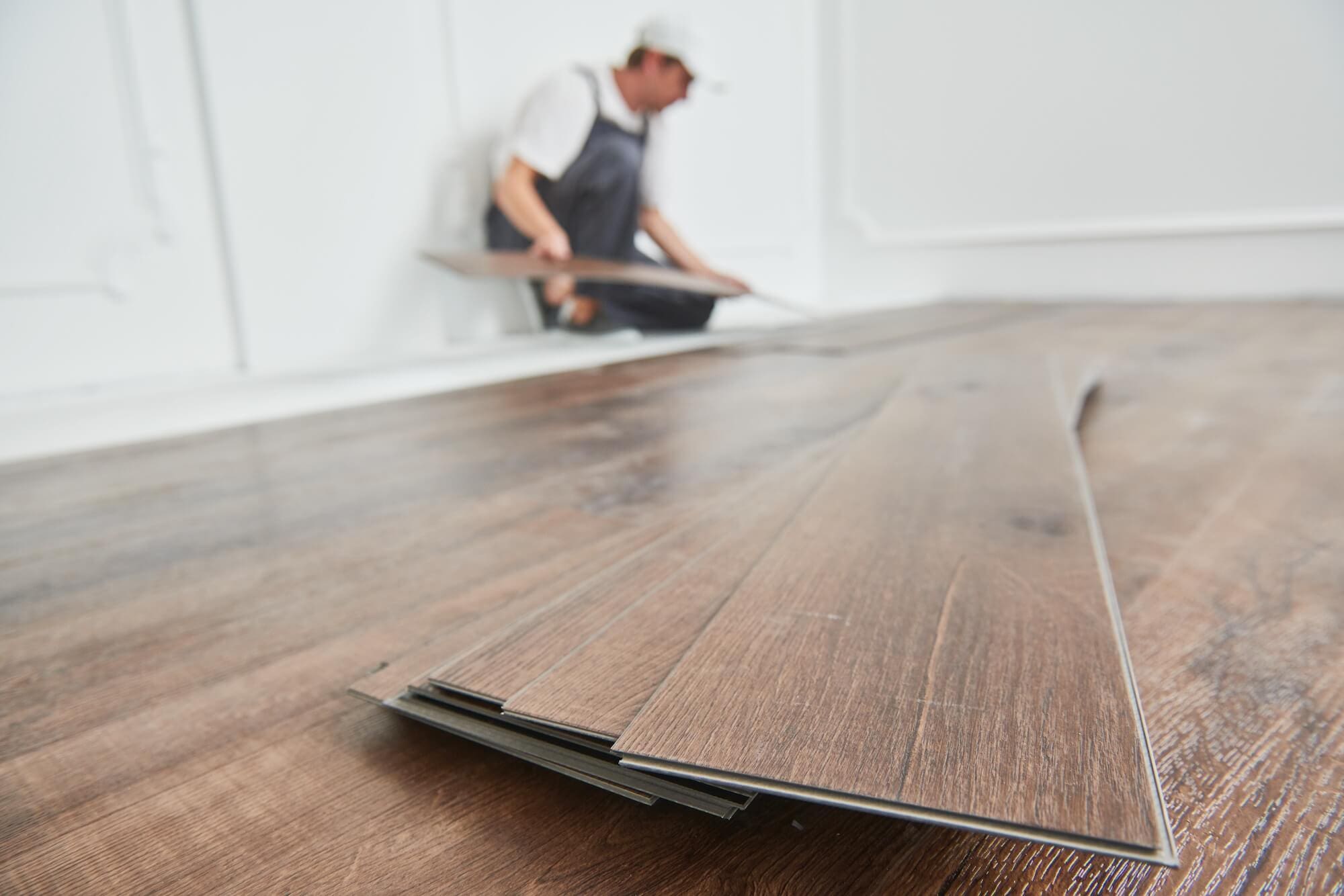Creating a workout space at home is exciting, but the best flooring for home gym setups isn’t always obvious. Home gym flooring can make your gym safer, more durable, quieter, and even more inviting.
Choosing the wrong option can lead to slips, damaged exercise equipment, or early wear. Picking wisely will make every workout smoother and every investment last longer.
Why the Right Home Gym Flooring Matters
When designing a home gym, flooring often takes a back seat to machines or dumbbells. That’s a mistake. The best flooring for home exercise room is the foundation for performance and safety.
- Safety: Slip resistance and impact absorption protect your joints and prevent falls.
- Durability: Good flooring withstands heavy equipment, sweat, and movement without breaking down.
- Noise Isolation: Soundproofing matters if your gym is above living spaces or next to bedrooms.
- Aesthetic Value: A welcoming space encourages consistency in workouts.
Companies like Peach Flooring can help you pick and install the right flooring for your workout space, ensuring it’s functional, premium flooring quality, and long-lasting. With professional advice, you’ll know exactly which gym flooring matches your equipment and exercise routine.
Key Criteria to Consider For Best Flooring For Home Gym
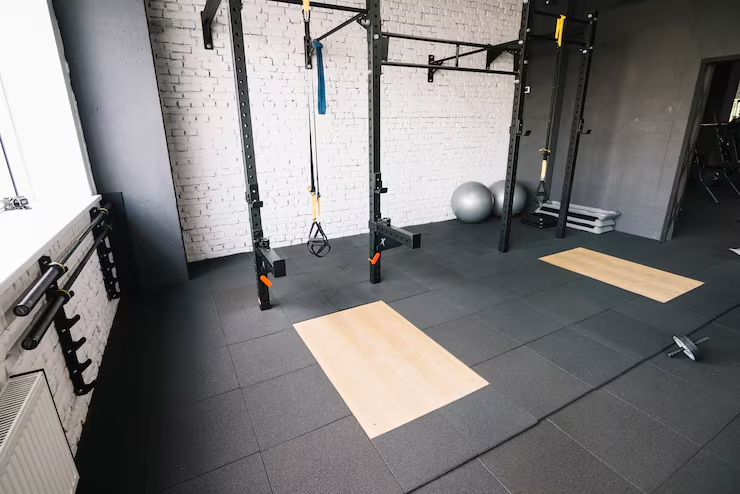
Alt text: Modern gym with black rubber gym flooring, wooden lifting platforms, strength training rigs, and fitness equipment against a white brick wall.
Before you choose the best flooring for home exercise room, keep these criteria in mind:
- Shock Absorption: Protects joints and cushions dropped weights, offering excellent shock absorption.
- Durability: Flooring must resist scratches from gym equipment, dents, wear and tear, and heavy loads from gym equipment.
- Slip Resistance: Prevents accidents when moisture or sweat is present.
- Ease of Cleaning: Sweat and dirt build up quickly, so flooring must be simple to sanitize.
- Noise & Vibration Control: Especially critical in upstairs rooms or garage gyms.
- Thickness & Density: Heavier loads and heavy exercise equipment require thicker flooring materials.
- Installation & Subfloor Compatibility: Moisture barriers, adhesives, and evenness matter, especially over cold concrete or basement floor areas.
- Design & Aesthetic Fit: Flooring material should match your décor and motivate you to use the gym space.
- Cost: The best flooring options for homes balance price with performance per square foot.
Types Of Best Flooring For Home Exercise Room
Here’s where we dive into gym flooring options. Each choice has strengths and tradeoffs, but together they make up the core of what you’ll see in the best flooring for home exercise room setups.
1. Rubber Flooring
Rubber is often considered the best home gym flooring. It comes in rolls, rubber tiles, or interlocking tiles. Rubber flooring remains one of the most trusted gym flooring materials because of its durability and safety.
- Shock Absorption: Excellent for protecting joints and equipment. Rubber flooring rolls range from ¼” for light use to ½” or more for weight room setups.
- Durability: Extremely durable and resistant to wear. Recycled rubber makes it eco-friendly too. It’s also the best rubber gym flooring if you lift heavy weights regularly.
- Slip Resistance: High grip, even when damp.
- Noise Isolation: Dense and reduces noise, making it ideal for upstairs gyms.
- Tradeoffs: Appearance can be basic, seams may show.
Rubber mats, rubber floor tiles, and rolled rubber are also great if you need the best flooring for home gym over a concrete floor, since they soften impact and create a cushioned surface. Stall mats and rubber underlayment provide extra protection under heavy equipment. Overall, rubber flooring stands out as a versatile option for garage gyms and basement floors alike.
2. Vinyl Flooring (Luxury Vinyl Tile, Vinyl Planks, or Sheet Vinyl)
Vinyl flooring is popular because it balances practicality with style. For many, it’s the best flooring for home gyms where aesthetics matter.
- Shock Absorption: Limited, so it works better for cardio, floor exercises, or yoga mat workouts.
- Durability: High quality flooring, resistant to scratches and moisture.
- Slip Resistance: Excellent grip with textured surface options.
- Ease of Cleaning: Simple to maintain, moisture resistant.
- Tradeoffs: Less cushioning under heavy weights—may require underlayment.
Vinyl planks or luxury vinyl tile are versatile and attractive, often recommended as correct gym flooring for basement floor areas or humid climates. This type of home gym flooring adds a polished, modern look to your workout space.
3. Foam / EVA Puzzle Mats
Foam tiles and foam mats are lightweight, easy to install, and budget-friendly gym flooring.
- Shock Absorption: Cushioned surface, perfect for yoga, Pilates, or floor exercises like jumping rope.
- Durability: Can compress under heavy weights and heavy exercise equipment.
- Slip Resistance: Adequate for light workouts, but interlocking mats may shift on uneven surfaces.
- Noise Isolation: Moderate.
High density EVA foam tiles are easy to install, flexible, and cover an entire floor or just a section of your gym space. Foam flooring is ideal for garage gyms with lighter loads. This style of home gym flooring keeps your floor safe while remaining cost-effective.
4. Engineered Wood / Laminate
For elegance, engineered wood and laminate bring warmth into a workout space.
- Shock Absorption: Minimal without extra mats.
- Durability: Holds up for light activity but vulnerable to dropped weights.
- Aesthetic: Stylish and blends with hardwood floors in existing floor areas.
- Tradeoffs: Not moisture resistant, poor for heavy equipment.
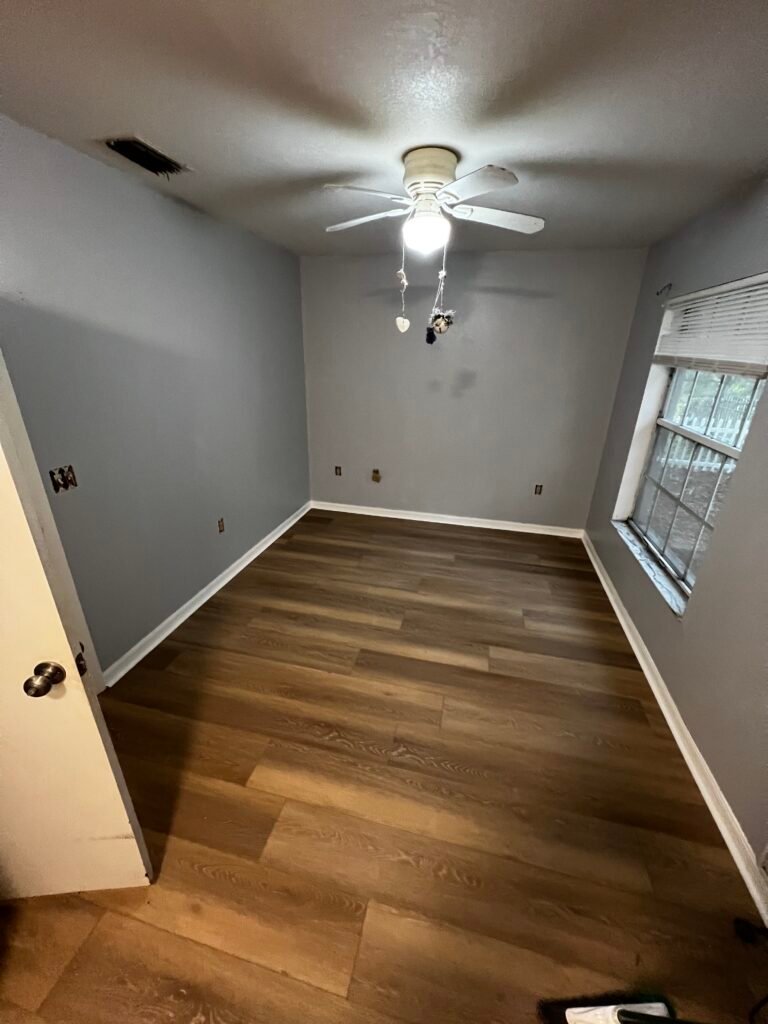
Alt text: Compact bedroom with newly installed light brown gym flooring, gray walls, ceiling fan, and single window for natural light.
File name: gym-flooring-bedroom-installation.jpg
Best for cardio or yoga rooms with a yoga mat, not weight rooms. While it isn’t the best flooring for home gym setups overall, it can work in multipurpose fitness rooms.
5. Cork Flooring
Made from cork oak trees, cork flooring is eco-friendly and shock absorbent.
- Shock Absorption: Springy cushioned surface.
- Durability: Softer, vulnerable to punctures from heavy weights.
- Noise Isolation: Naturally reduces noise.
- Maintenance: Must be sealed against moisture.
Best for lighter workout space setups, not for commercial gym standards. This option brings warmth and character but falls short compared to rubber flooring.
6. Artificial Turf
Artificial turf is a unique gym flooring material perfect for functional training.
- Shock Absorption: Good with underlayment.
- Durability: Handles sled pushes and heavy wear.
- Aesthetic: Athletic, premium flooring appearance.
- Tradeoffs: Traps sweat and dirt, requires brushing.
Pair with rubber mats or foam tiles for heavy equipment zones. Turf is not always the best flooring for home gym, but for agility or sled drills, it’s unmatched.
7. Sprung Floors / Performance Floors
Advanced flooring options found in dance studios.
- Shock Absorption: Outstanding cushioned surface for joint safety.
- Durability: Premium flooring for athletes.
- Tradeoffs: Expensive and not easy to install.
Rare for home gyms but excellent for specialized training. Not considered typical home gym flooring, but excellent shock absorption makes it appealing for certain users.
8. Hybrid Flooring Solutions
Many use hybrid flooring solutions: rubber flooring for weight room zones, vinyl flooring for cardio, and foam tiles for stretching or floor exercises. By combining gym flooring materials, you get correct flooring for every workout type.
Thickness & Load Matching
- Heavy Weights: Rubber flooring rolls or rubber gym mats with thicker gym flooring.
- Light Cardio: Foam flooring or interlocking tiles.
- Yoga / Pilates: Engineered wood with yoga mat or cork flooring.
This mix ensures the best flooring for home gym performance in every workout space.
Subfloor Prep & Installation
To protect your existing floor from wear and tear:
- Level uneven surfaces.
- Add moisture resistant barriers over cold concrete.
- Use rubber underlayment or flexible PVC layers.
- Seal edges and interlocking mats.
DIY works for foam flooring, but commercial gym-level results need professional installation. Proper prep guarantees your home gym flooring lasts for years.
Maintenance & Longevity
- Clean sweat regularly with pH-neutral cleaners.
- Rotate foam mats to reduce wear and tear.
- Inspect seams in interlocking tiles or carpet tiles.
- Replace flooring rolls or stick carpet tiles when needed.
With routine care, your gym flooring will stay extremely durable and ready for heavy exercise equipment.
Reduce Noise, Sound & Vibration
Reduce noise with:
- Rubber material for excellent shock absorption.
- Stall mats under heavy weights.
- Cushioned surface under fitness equipment to protect the flooring underneath.
This makes rubber flooring one of the best solutions for garage gyms and upstairs gym space setups.
Aesthetic & Design Of Flooring and Gym Equipment
Your gym flooring should match fitness goals. Choose recycled rubber, vinyl planks, or textured surface finishes. Peach Flooring offers flooring options for garage gyms, basement floor builds, or upstairs gym space with style. With the right flooring, your workout space will look and feel professional.
Common Mistakes To Avoid When Planning Gym Flooring
- Using thin foam mats under heavy exercise equipment.
- Ignoring noise reduction in garage gyms or upstairs rooms.
- Skipping moisture barriers on concrete floor.
- Overlooking transitions from one gym flooring material to another.
- Choosing gym flooring that’s not easy to install or maintain.
How Peach Flooring Helps
- Consultation: Choosing gym flooring for your workout space.
- Recommendations: Rubber flooring options, vinyl planks, foam mats, or carpet tiles.
- Installation: Rolled rubber, rubber gym mats, or luxury vinyl tile fitted seamlessly.
- Aftercare: Tips to protect gym flooring underneath your fitness equipment.
With Peach Flooring, you get extremely durable flooring options tailored to your fitness goals. Their expertise ensures you always get the best flooring for home gym setups.
Next Steps
The best flooring for home gym depends on your needs. From rubber gym mats to foam tiles, artificial turf, or vinyl planks, there’s a flooring option for every gym space.
Contact Peach Flooring today for premium gym flooring solutions and professional installation that keeps your entire floor safe, cushioned, and ready for years of workouts.
